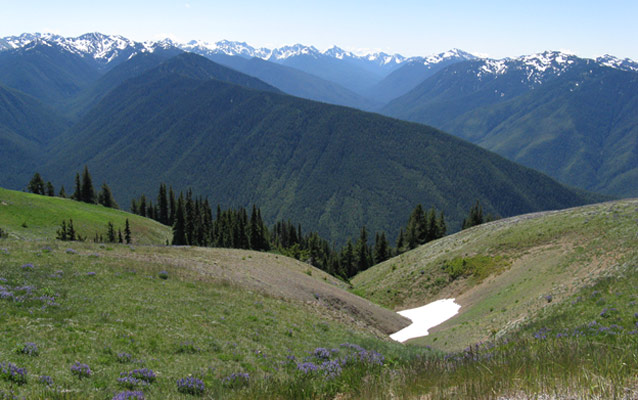Last updated: March 25, 2020
Lesson Plan
Freeing the Elwha (Aspect and Soil Moisture)

- Grade Level:
- Middle School: Sixth Grade through Eighth Grade
- Subject:
- Science
- Lesson Duration:
- 60 Minutes
- Common Core Standards:
- 6-8.RST.1, 6-8.WHST.2
- State Standards:
- State: WA
Subject : Science
Grade Level: 6-8
State Standards:
EALR 4: 6-8 LS2C, EALR 4: 6-8 LS2D
Reading
EALR 1: Component 1.2
Social Studies
EALR 5: Component 5.2
Writing
EALR 2: Component 2.1 - Additional Standards:
- Next Generation Science:
MS-ESS2-2. Construct an explanation based on evidence for how geoscience processes have changed Earth’s surface at varying time and spatial scales. - Thinking Skills:
- Remembering: Recalling or recognizing information ideas, and principles. Understanding: Understand the main idea of material heard, viewed, or read. Interpret or summarize the ideas in own words. Applying: Apply an abstract idea in a concrete situation to solve a problem or relate it to a prior experience. Analyzing: Break down a concept or idea into parts and show the relationships among the parts.
Essential Question
What combination of factors both natural and man made is necessary for healthy river restoration and how does this enhance the sustainability of natural and human communities?
Objective
To understand the role that aspect, slope, sun, snow melt, blackbody absorption and elevation play in soil moisture conditions.
Background
This lesson focuses on the role of aspect, slope, seasonal sun availability, snow melt, blackbody absorption, and elevation in soil moisture conditions. Soil moisture is one of the most important factors determining the composition of plant communities and ultimately the ecosystem structure. The amount of snowpack and the amount of time it takes to melt off each summer impacts the growing season and the ability of trees to survive. Where trees can no longer survive, alpine meadows predominate, but soil moisture conditions determine whether they are "wet" or "dry" meadows.
Preparation
The teacher should review the background information and have the Aspect and Soil Moisture Powerpoint available as well as the Aspect and Soil Moisture worksheet. There should also be copies of the Demonstration/Lab Activity Sheet available and the materials needed: metal or glass pan, shaved ice, black rubber stopper or another dark object, freezer and/or refrigerator, and an electric lamp with a hot light bulb.
Materials
The presentation provides visual examples of key terms and explains other aspects of the material to be taught.
Download Aspect and Soil Moisture PowerPoint
Will allow student to record personal thoughts on the lesson.
Download Demo Lab Activity Sheet
Procedure
-
Review the Essential Question. Introduce the guiding question.
-
Students should take a few minutes to respond to the first reflection prompts. Discuss their answers and any questions they’ve generated.
-
Hand out the Vocabulary Notes. With this lesson you may want to define the words before presenting the PowerPoint Lesson.
-
Present the PowerPoint Lesson.
-
Run demonstration on blackbody radiation absorption.
-
Hand out the second Reflection Journal Page. Give students time for a final reflection on the lesson.
Vocabulary
- Aspect: The direction a slope faces
- Snowpack: The seasonal accumulation of snow in the winter that is available for melting in the spring and summer.
- Solstice: Either of two times of the year when the sun is at its greatest distance from the celestial equator. The summer solstice in the Northern Hemisphere occurs about June 21, when the sun is in the zenith at the tropic of Cancer; the winter solstice occurs about December 21, when the sun is over the tropic of Capricorn. The summer solstice is the longest day of the year and the winter solstice is the shortest.
- Equinox: Either of the two corresponding moments of the year when the Sun is directly above the Earth's equator. The vernal equinox occurs on March 20 or 21 and the autumnal equinox on September 22 or 23, marking the beginning of spring and autumn, respectively, in the Northern Hemisphere (and the reverse in the Southern Hemisphere). The days on which an equinox falls have about equal periods of sunlight and darkness.
- Analemma: A graduated scale in the shape of a figure eight, indicating the sun's declination and the equation of time for every day of the year and usually found on sundials and globes.
- Blackbody absorption: an ideal black substance that absorbs all and reflects none of the radiant energy falling on it.
Assessment Materials
Aspect and Soil Moisture Reflection JournalsHave students complete journal entries to assess comprehension of key concepts.
The material allows the teacher to see how well students can analyze the information taught, evaluate its merits and apply the information to their own thinking.
Additional Resources
